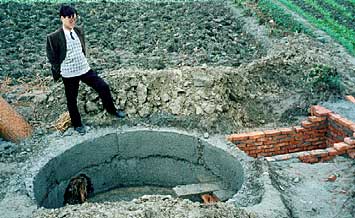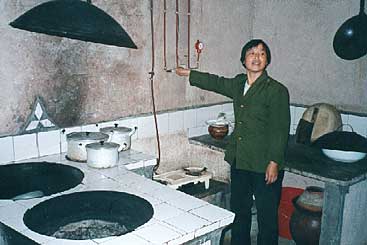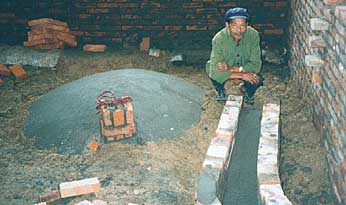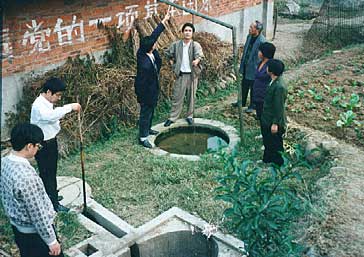Anaerobic Digestion in Rural China

By J. Paul Henderson, P.Eng.
E-mail: paul.henderson@vancouver.ca
Introduction
Approximately 70 percent of China's 1.2 billion people live either on farms or in villages. No formal waste management systems are in place for these people. The primary waste products generated by rural households include agricultural by-products such as straw and sweet potato vines, human wastes, animal wastes, and food waste.
Since the 1970s, China has been promoting the use of underground, individual household scale, anaerobic digesters to process rural organic wastes. There are approximately 5,000,000 households using anaerobic digesters in China. The digesters produce biogas that is used as an energy source by the households, and produce fertilizer that is used in agricultural production.

Partially completed reactor, influent port at left of picture, effluent port at right of picture.
Waste Management Alternatives
A range of options are available for managing rural wastes. Non-recyclable inorganic wastes tend to accumulate in any unused piece of land. Management practises for organic wastes include feeding them to animals, using them directly as a fertilizer, composting and anaerobic digestion.
Food waste and many agricultural by-products are fed to farm animals as supplements to commercial feed.
Households that do not have digestion systems use unprocessed human and animal manure as fertilizer. Waste from toilets and animal pens is stored in open pits until required. The waste is then scooped out of the pits and delivered to the field.
Simple composting systems are also used for processing waste. The waste is piled up, covered with soil, and allowed to compost.
Anaerobic digestion has the advantages of producing energy, producing high quality fertilizer and also preventing the transmission of disease.

Kitchen showing wood or straw stove at left, biogas stove at right and pressure gauge at right.
Feedstocks
Feedstocks used in the anaerobic digesters depend on what organic wastes are produced by the family. For the most part, food wastes are consumed by pigs and chickens. Therefore, organic wastes potentially available for digestion include human and animal wastes, and agricultural by-products such as grain stalks (primarily rice), sweet potato vines, and weeds.
When the digesters were initially promoted, one of the main waste materials processed in the digesters was rice stalks. The rice stalks were processed because insufficient other organic wastes were available, and also, early digesters were large scale and used mechanical equipment for cleaning. Experience has shown that in household based systems, grain stalks tend not to break down very well, and cause the formation of a crust of up to one metre thick inside the digester.
In addition to reducing the efficiency of the digester, the crust needed to be removed in an annual clean-out. The only way to remove the crust was to enter the digester from a port at the top of the reactor. Removing the crust and the accumulated material was not only difficult work, but also dangerous due to the explosion potential and absence of oxygen.
In Sichuan Province, as a result of an increase in meat consumption, most agricultural families now raise 2-4 pigs for market at a time. The combination of human waste and animal manure provides sufficient feedstock to meet the majority of the energy needs of the family. Other organic wastes such as spoiled food wastes, grain husks and weeds are added in small quantities. Grain stalks are either burned directly as fuel during winter when gas production drops or are sold as a paper feedstock.

Completed Reactor showing dome top, gas port and toilet and pigsty influent channels at right. Entire structure will be covered with pigsty floor
Reactor Design and Construction
Reactor design has evolved over time. The basic design has historically been a cylinder shaped main reactor with a domed top. Waste material is fed into the reactor through a port that is connected into the bottom of the reactor.
Early reactors had a separate effluent storage container that was connected to the main reactor by a pipe attached below the water-line.
A port was constructed at the top of the reactor to allow reactor clean-out. To maintain a gas seal, the lid had to be heavy making it hard to remove. To allow feeding a variety of materials into the reactor, the influent port was generally relatively large and located outside. This meant that human and animal waste had to be manually collected and fed into the reactor.
Modern designs have simplified the construction of the system. There is no longer a port at the top of the reactor. The effluent chamber and reactor are now connected, and generally, toilets and pigsties are connected directly to the influent port.
In the standard design, effluent is removed from the reactor at the top of the water column. Thus supernatant is collected rather than sludge. Additionally, no mixing of the system occurs when effluent is removed. In some systems, a vertical cylindrical pull-rod port is added at the side of the effluent port. The pull-rod port connects into the base of the effluent port. Effluent is removed by moving a pull-rod up and down in the port. The pull-rod is simply a wooden shaft with a metal disk on the bottom. In addition to simplifying effluent removal, as a bucket can be placed directly under the pull-rod port, removing the effluent provides some mixing in reactor.
In the standard reactor design, the head space volume above the reactor is essentially fixed, although the volume increases slightly with increasing pressure since the effluent port liquid level moves up and down with pressure changes. Additionally, if effluent is not regularly removed from the system, the liquid volume in the reactor increases reducing the head space volume. As a result, gas pressure delivered into the home varies. This causes variation in heat produced by cooking elements and variation of gas lamp light intensity. To resolve this problem, some systems are constructed with a separate gas storage chamber. The gas storage chamber has a floating cover to maintain constant pressure regardless of gas volume. The system consists of a cup-shaped concrete storage container floating up-side down in a tank of water. The cup moves up and down in the tank with changes in gas volume.
Another advantage of this type of storage system is that during cold weather, moisture in the gas condenses in the storage container rather than in the gas line. Condensate in supply lines can block the lines or cause oscillating gas pressure.
Construction of the reactors is completed by trained technicians and members of the household building the reactor. The technicians are local residents who have been trained by the local government to construct the reactors. They construct reactors as a sideline to their regular work. The basic construction materials for the reactors are concrete and bricks, easily available and commonly used in construction in rural China.
Following excavation of the reactor pit, a simple cylindrical form is used for pouring the basic reactor body. Both the base and domed top are constructed by laying bricks to create the shape, and covering the bricks with a layer of concrete. The gas exit port is installed at the top of the dome. A domed top is used because a domed design allows the construction of the reactor with-out reinforcing the concrete, reducing the cost of the reactor.
The areas of construction requiring the most skill are the construction of the domed top and ensuring the system is sealed. The seal is tested prior to operation.
Most reactors are built in conjunction with the construction of new pigsties and toilet facilities. The reactors are located directly under the floor of the pigsty and the drain from the pigsty as well as the toilet feed directly into the reactor.
Construction time for a reactor is approximately one week, and the total cost including materials and the cost of the technician is approximately $80 US.
System Operation and Maintenance
The modern automatically feeding systems are particularly simple to operate and maintain. Waste from the pigsty and toilet flows directly into the reactor. The toilets are simple Asian squat style toilets with the plumbing feeding into the reactor influent port. Many of the homes have no running water, and in all cases the toilets are non-flushing and water is added manually for cleaning. According to Hong (1993), ideally, daily infeed to a 6 cubic metre reactor should be approximately 30 kilograms of feces and other organics waste plus approximately 50 kilograms of water and urine. The net solids of the material entering the reactor should be approximately 8%.
Manually fed systems require more work. Waste material must be transferred from the initial storage pits and delivered to the influent port of the reactor.
Ideally, material should be collected from the effluent port and flushed back into the influent port to promote mixing of the reactor. Few farmers actually do this.
When rice stalks were a primary feed material, an annual clean-out of the reactor was required to remove the reactor crust as well as accumulated sludge. Now that the primary feed materials are animal and human wastes, no crust accumulates, and therefore no annual clean-out is required. Effluent is simply removed as required.

Effluent port with pull-rod effluent remover (left) and floating cover gas storage container at right.
Gas Utilization
From the farmers point of view, the primary reason for constructing a digester system is to produce biogas. The gas is approximately 60% methane, and the reactors produce in the order of 0.1-0.2 m3 biogas/m3/day, or approximately 0.25 to 0.3 m3 biogas/kg total solids (total solids:volatile solids equals 1.3).
Gas production is temperature dependent, with production being inhibited at mean ambient temperatures less than 10°C. More than half of China's rural population are in areas where mean ambient temperatures exceed 10°C, 8 to 12 months of the year.
Gas pressure from the systems ranges from 0 to 80 centimetres of water, and each system has a pressure meter to measure the pressure.
The gas is used primarily for cooking and lighting. A digester can provide approximately 60% of a family's energy needs. During winter months, when gas production drops, straw, firewood and coal are used for cooking, and electricity is used for lighting. All of the kitchens have a traditional fuel stove in addition to the gas burner.
Effluent Utilization
The effluent from the reactors is an odourless dark coloured slurry. The primary application of the effluent is as an agricultural fertilizer. Other applications include as a feed supplement for pigs, mushroom growing media, fertilizer for fish ponds, worm rearing media (the worms are then fed to chickens), and media for soaking seeds prior to germination.
As an agricultural fertilizer, according to Wu and Liu (1988), using anaerobic reactor effluent instead of chemical fertilizer increased a field's net economic yield by 30%. In general, the effluent is used as a supplement to chemical fertilizers reducing chemical fertilizer requirements.
Anaerobically digested fertilizer also increases yields compared to material composted aerobically presumably due to the conservation of nitrogen in an anaerobic system. According to Long (1992), compared to manure stored in an open top storage pit, effluent from a six cubic metre anaerobic digester increased annual tree fruit production by 300 kg.
According to Di (1993), compared to traditional practises, using anaerobic effluent in mushroom production increases yields by 30%, increases fish production by 6-12%, and reduces the cost of producing pigs. According to Hu et al. (1993), soaking seeds in anaerobic reactor effluent for 12 hours prior to germination rather than soaking in water increases corn sproutability from 92.5% to 95%, and increases early growth in the plants by 5%.
Environmental and Sanitation Considerations
There are many environmental and sanitary benefits of using biogas technology.
According to Long (1993), a five person family in Guangxi uses the equivalent of 2100 kg/year of firewood in fuel. Within a few years of installing reactors in every home in a village of 125 families, the forest around the village became more luxuriant and springs that had been previously drying up increased in volume. Although this account is anecdotal, it points out the impacts of biogas technology in conserving fuel and protecting forests.
The most obvious sanitary benefit of installing an anaerobic digester system is the improvements to toilet facilities in the households. Throughout China and other developing countries, where no sewer system is in place, toilet facilities are in simple shacks. The toilet is generally a slot in the floor with either a pit underneath or alternatively a trough running to a storage pit behind the building. In the case of a pit toilet, the slurry in the pit is often literally moving with insect larvae, and in all cases the toilets are smelly and fly infested. For these reasons, toilets are generally located as far away from the other household buildings as practical.
In comparison, toilets automatically feeding into an anaerobic digester are odourless and fly-less, and are as clean as toilets connected to sewer systems. The toilets are located in the main housing building often directly adjacent to the kitchen.
The other sanitary benefit of the digesters is that disease-causing organisms are killed during the digestion process. This is important in protecting the people consuming the farm produce, and also in protecting the workers in the fields, as they are in direct contact with the fertilizer while maintaining the crops.
Conclusion
In rural China, anaerobic digesters are important tools in providing energy for households as well as producing agricultural fertilizer. Other benefits of the systems include improved sanitation and conservation of alternative fuels.
References
Di, C.L., 1993, "Characteristics and Role of Good Cycle System for Rural Biogas in Jiangsu Province (Chinese)", China Biogas, 11(2), pp. 51-53.
Hong, J.X., 1993, "Common Applications for the Operation Rules of Fermentation Technology of Household Biogas Digester (Chinese)", China Biogas 11(2), pp. 25-26.
Hu, F.C. et al, 1993, "Test on Preventing Insect Pest of Maize and Effect in Increasing Maize Production by Applying Biogas Slurry (Chinese)," China Biogas 11(2), pp. 42-43.
Long, C., 1992, "Review and Prospects for Biogas Development in Guanzi Zhuang Autonomous Region (Chinese)", China Biogas 10(3), pp. 1-4.
Wu, Y.Z. and Liu K.J., 1988, "An Introduction to the State of Research and Development of Biogas in Rural Areas of China in Recent Years and Discussion on Improvement of Old Biogas Technology (Chinese)", Biogas Technology and Utilization Research, Chengdu Biological Science Research Institute, pp. 1-13.
Author
Paul Henderson is an Environmental Engineer with the City of Vancouver, Canada. Paul wrote this article while on a six month leave of absence studying waste management systems in the Peoples' Republic of China. Paul's research was funded by the Canadian International Development Agency, the Sichuan Provincial Commission of Science and Technology, and the Solid Waste Association of North America. This paper would not have been possible without the assistance of the Mianyang, Sichuan Province, Municipal Biogas Office. Paul can be contacted at the City of Vancouver, 453 West 12th Avenue, Vancouver, B.C. Canada, V5Y 1V4, or by e-mail at paul.henderson@vancouver.ca
Our exam 70-686 and exam 70-432 resources are playing a vital role in IT world. If you are looking for fast success in mcdst 70-271 exams then join us today to explore complete 70-432 pdf & 70-523 exam resources.
![[new]](new01.gif)
